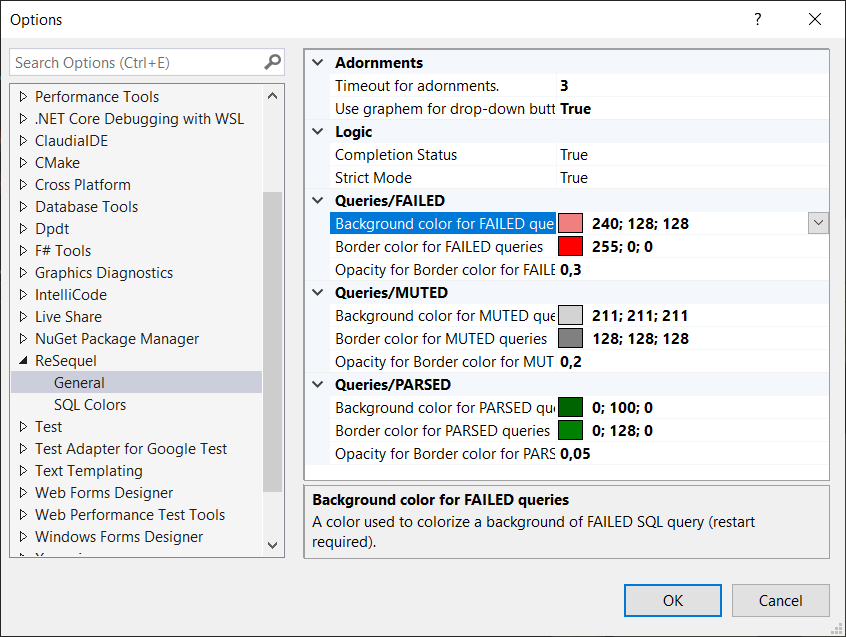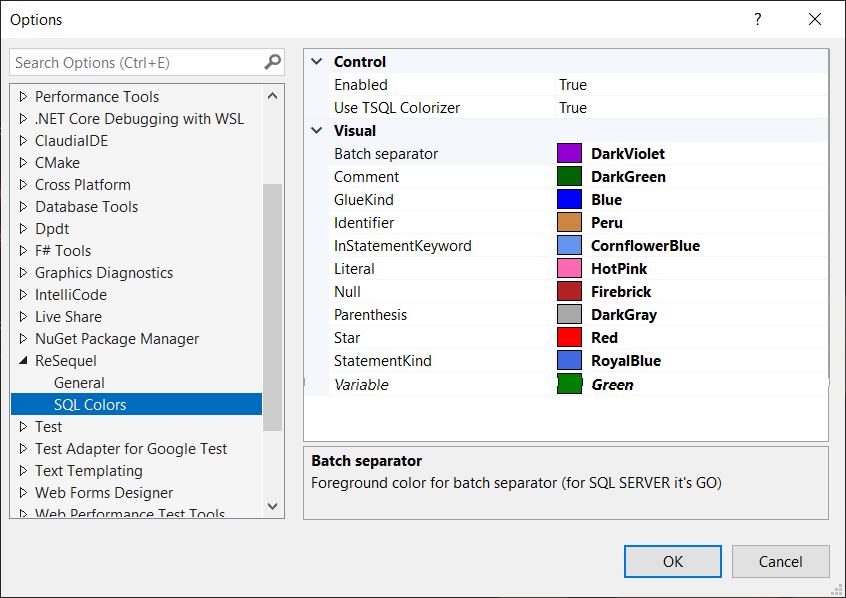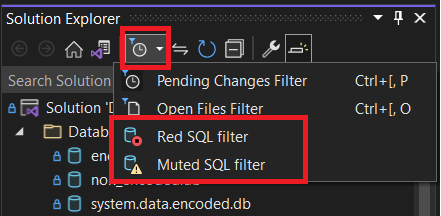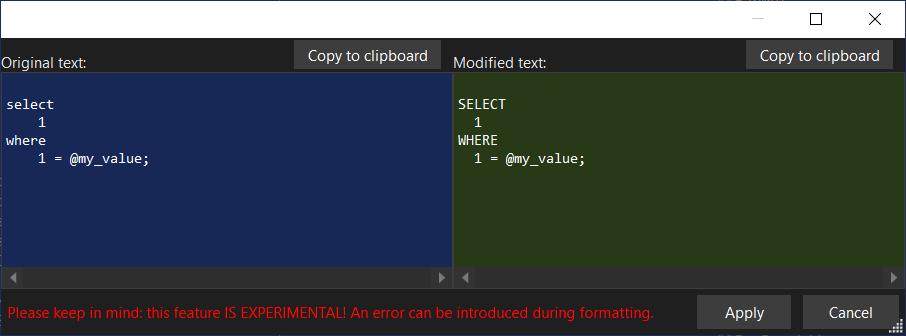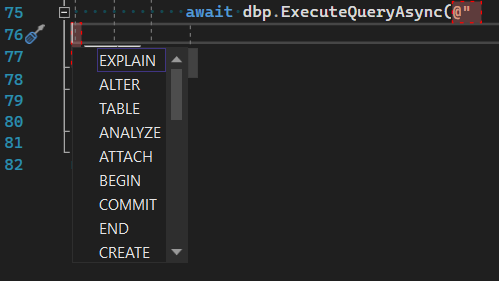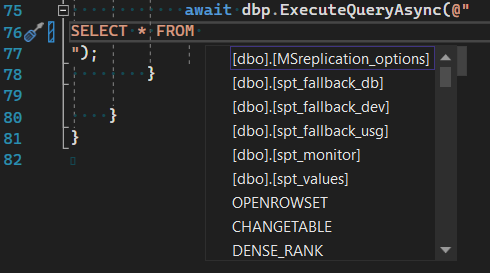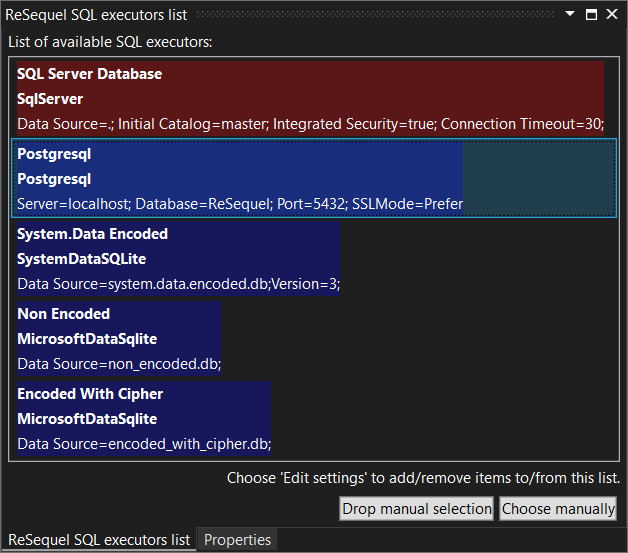Let's say we're working on a project that uses an RDBMS but doesn't use an ORM. You are using plain SQL, the queries of which are written in the source code. This is not a uniquely bad approach, it has pros and cons. The upside is that you eliminate a whole software layer (ORM) that can be buggy and consumes CPU cycles and RAM bytes. In addition, I am convinced that plain SQL is easier to read and understand than the Aesopian language of various ORMs. The main disadvantage of this approach is that when changing the database schema, it is difficult to find all the queries that need to be changed in the codebase. Errors of this kind usually show up at runtime. ReSequel aims to fix this problem.
ReSequel is a tool for validate SQL queries in your code against your database schema. ReSequel can work as a console program, and as a Visual Studio 2019/2022 extension (VSIX).
In any mode ReSequel DOES NOT run your program, and DOES NOT run your SQL queries to actual execution, but ReSequel uses RDBMS engine to do various tasks like syntax validation, etc. ReSequel is powered by Roslyn and uses it to extract SQL queries from your code. Places which contains SQL qieries are defined in a ReSequel XML setup file that can be differenet for different sln/slnf.
ReSequel supports Microsoft SQL Server 2012 (and later), SQLite 3 and Postgres (beta).
For run ReSequel in command line mode please build ReSequel.csproj. You will receive ReSequel.exe that require 5 command line arguments:
- 1st argument: path to you
sln/slnffile - 2nd argument: path to
ReSequelSetup.xmlfile - 3rd argument: a RDBMS type (
SqlServer,SystemDataSqlite,MicrosoftDataSqlite,Postgresql) - 4th argument: connection parameters.
- 5th argument: a connection string to your database.
After that, ReSequel will build your sln/slnf, gets its compilation symbols (via Roslyn), scans that symbols for SQL queries (using ReSequelSetup.xml), validate found queries against your DB schema, and print analysis result into console.
As a structured artifact ReSequel stores its results into the file report.json that can be picked up for analyzis.
Examples for command lines:
SqlServer
C:\projects\github\ReSequel\DbProviderExample\DbProviderExample.sln C:\projects\github\ReSequel\DbProviderExample\ReSequelSetup.xml SqlServer "Data Source=.; Initial Catalog=master; Integrated Security=true; Connection Timeout=30;" "" True
SystemDataSqlite
C:\projects\github\ReSequel\DbProviderExample\DbProviderExample.sln C:\projects\github\ReSequel\DbProviderExample\ReSequelSetup.xml SystemDataSqlite "Data Source=system.data.encoded.db;Version=3;" "Password=mypassword;CaseSensitive=False" True
MicrosoftDataSqlite
C:\projects\github\ReSequel\DbProviderExample\DbProviderExample.sln C:\projects\github\ReSequel\DbProviderExample\ReSequelSetup.xml MicrosoftDataSqlite "Data Source=encoded_with_cipher.db;" "Password=mypassword;CaseSensitive=False" True
Postgresql
C:\projects\github\ReSequel\DbProviderExample\DbProviderExample.sln C:\projects\github\ReSequel\DbProviderExample\ReSequelSetup.xml Postgresql "Server=localhost; Database=ReSequel; Port=5432; SSLMode=Prefer" "" True
This mode is useful in automation scenarios.
For a programmer a Vsix mode has been developed. You need to download compiled distro here for a Visual Studio 2019 and here for a Visual Studio 2022.
After installing ReSequel extension into your Visual Studio, you find the following menu:
ReSequel Solution Statusallows you to control ReSequel status for current solution. ReSequel stores itsxmlfiles in context of solution, so you need to open solution to make ReSequel fully functional.Edit Settingsallows you to editReSequelSetup.xml.Choose default SQL executorallows to change a target database (different SqlServer/Postgres instances/databases, or even SqlServer/Sqlite/Postgres databases)Solution-wide SQL scanneris able to scan your solution in the same way as console mode doing that; but results will be put in tool window inside Visual Studio. Additional details can be found below.Reset SQL colorizationresets SQL colorization colors to its defaults.Open ReSequel Optionsopens a ReSequel options page. It can be doing manually in menu Tools/Options/ReSequel.Show ReSequel release notesopens a ReSequel release notesmdfile. It is recommended to install a Markdown editor Visual Studio Extension into your Visual Studio instance. Also, a Release Notes Notification goldbar will show at the start of Visual Studio, if ReSequel found that a new version of itself has been installed.
This mode is useful in everyday developping activities.
For demonstation purposes we will work with DbProviderExample.sln from this repository and a local SQL Server instance with instance name ..
- At first, clone this repo to your computer.
- Next, install ReSequel Visual Studio Extension from marketplace.
- Next, you need to open solution you will work with. Open
DbProviderExample.sln. - Invoke
ReSequel Solution Statuscommand and create aReSequel Configuration Generic FileandReSequel Setup Generic Fileif they does not exists (for aDbProviderExample.slnthese files exists, so this step may be skipped). - Invoke
Edit Settingscommand and edit command line for SQL Server executor; save this file. - Open any
csfile which contains SQL queries, for exampleUnsorted.cs; wait for a few seconds, you will see something like this:
The things you see are
Green ones means SQL query has been validated successfully. Red - validation fails because of errors in SQL queries or because the queries cannot be parsed at compile time. Gray - queries are muted (probably, queries cannot be validated for some reason and were muted by a programmer). All of these colors can be customized in ReSequel options.
As you started to write your code, all ReSequel adornments disappears to make your typing as fast as Visual Studio can. A few seconds later after you stopped to modify the text, ReSequel starts scanning again and validation results and colorization gets back.
Behaviour of ReSequel can be modified in various aspects.
Here are the options for SQL queries background colors and opacity, border colors, completion status and a switch for a strict mode:
Timeout for adornmentsis a timeout in seconds you need to wait unitl adornments shows up after you stopped typing.Use graphem for drop-down buttonsreplaces text via the short Unicode graphems to save your screen space.Completion Statusenables a completion list during typing a C# literals.Strict modeswitches ReSequel into the strict mode. Additional details about strict mode can be found below.- Color options setup a adornments colors.
Here are the options for foreground SQL colorization, switch to on/off it and ability to use TSQL colorizer for any SQL dialect:
Enabledenables a colorization of SQL tokens (yes, inside your C# string literals). Switching foreground colorization off makes VS UI smoother.Use TSQL Colorizermeans that ReSequel will use TSQL token colorizer for a non-SQL databases (sqlite, postgres). It may not be 100% correct, but in the other case colorization for sqlite/postgres will be disabled (due to absense of such SQL parsers in public domain).- Visuals contains a various colors for a various parts of SQL queries.
ReSequel Visual Studio Extension is able to scan your solution for a SQL queries and show the results. You are able to filter these results by a various parameters.
Please take a look how solution-wide scanner tool window looks:
For a sqlite\postgres some controls will be unavailable due to absense of such SQL parsers in public domain or other technical reasons.
If table/column/index/sql function names text box enabled, you can filter your list by pressing Filter results button.
Export queries saves your queries in structured text file.
If you had performed Solution-wide scanning, you are able to use solution filters now to easily find C# files with failed (RED) or muted SQL queries. These filters adopts information from solution-wide scanner, so you need to run it first.
Ctrl+C Defaultcopies current SQL into clipboard. If SQL database supports parsing queries, the required parameters will be added to the script.Ctrl+C Currentdoes the same, but for current selected SQL query in case of generator. Generators are explained below.Mute everywheremuted the query in every solution by added a special ReSequel-comment at the line above.Mute heremuted the query only for this solution. It may be useful in the case acsfile is included in a few csprojes/solutions.Build map classbuilds an anonymous C# class that contains a properties to map a SQL result set into. This class is indended to use withlinq2db.Build param classbuild an anonymous C# class that contains a parameters for the SQL query. This class is indended to use withlinq2db.Format queryopens an formatting window:
it's an experimental feature, so its button is yellow.
Some RDBMS may have subset of the buttons disabled because of absense of public SQL parser or other technical reasons.
Hints are special form single-line comments above your query. There are 3 hints now:
Mute everywherewill mute your query in any solution.Mute at (here)will mute your query in any solution which full file path is matched written wildcards.Skip insert column validationdisables this validation process step. It is useful in situations when you are inserting withidentity insert on.
ReSequel support auto completion for SQL keywords and a table\view names:
To show completion, put your cursor into string literal, and press Ctrl+., or post a space symbol or a tab. ReSequel does not ensure that this string literal is a "container" for a SQL query. These checks are very costly and uses a Compilation symbols from Roslyn. So, not to be surprised, if ReSequel will offer you to post a table name into your MessageBox message :)
Completion is in initial state of developing, so may work unstable.
Strict mode is a mode in which it is not allowed to omit into in an insert query, from in a delete query, and it is also required to explicitly specify columns in an insert query. Every such query will be recognized as FAILED.
This mode can be enabled in setup xml file.
Imagine that you are creating a bus ticket sales system. The system is half ready and now the customer asks you to create a report that will show the amount of sales for a certain period. Accordingly, you write something like this:
select sum(cost) from tickets where sell_date >= @date1 and sell_date < @date2Of course, in a real system, the report will be much more complex and meaningful. Now the customer is satisfied, but, as we all know, he is not satisfied for long. A couple of hours later, he comes to you again and asks you to make the SAME report, but not by the date the ticket was sold, but by the date of the trip. The request for it might look something like this:
select sum(cost) from tickets where trip_date >= @date1 and trip_date < @date2Here, the engineer has a choice: either create a new SQL query, or create logic that modifies an existing query, depending on which report the user requested. Both options have their pros and cons. Sometimes it's reasonable to allow almost the same queries in the codebase, sometimes it's preferable to modify the "skeleton" of the query for a specific report. Suppose, in our case, the engineer decided to take the second path. So he created a "skeleton" of the query:
select sum(cost) from tickets where {0} >= @date1 and {0} < @date2and using string.Format substitutes either sell_date or trip_date. There is a problem here: ReSequel does not execute the application code, but only works with compilation symbols. Therefore, such requests will not be visible to it and errors may appear in them when the structure of the DB changes.
"Generators" is a shorthand name for a mechanism that achieves both goals: to prevent clone queries in the codebase and to validate such non-constant queries.
To do this, we need to divide the problem into 2 parts: in the first part of the problem, we define the "skeleton" of the query and all possible "options" for it. All of these lines must be compile-time constants. In the second part of the problem, we need a mechanism that substitutes the specific, currently selected options at runtime.
ReSequel is completely oblivious to the second part, he knows nothing about it. ReSequel takes the "skeleton" query and iterates through all the options, substituting all available options into the "skeleton" and validating each option. If at least 1 option fails, the entire request is considered to be failed.
Let's move on to the code. Let's look at this example:
private string GetReportSql(bool useSellDateInsteadOfTripDate)
{
var generator = new ....;
var sql = generator
.WithQuery(@"
select sum(cost) from tickets where {0} >= @date1 and {0} < @date2
")
.DeclareOption("dateOption", "sell_date", "trip_date") //put into {0}
.MakeGenerator()
.BindToOption("dateOption", useSellDateInsteadOfTripDate)
.GenerateSql();
return sql;
}Everything before BindToOption is the first part of the problem, these are the expressions ReSequel looks at. Let's see how this code works.
The DeclareOption method contains the name of the option (dateOption), followed by a list(!) of valid values for the option. BindToOption contains the name of the option and a specific value indicating which of the DeclareOption values to select.
When the program is running, the generator takes into account which value from each option need to be substituted here-and-now, based on the expression BindToOption("dateOption", useSellDateInsteadOfTripDate) and the value of the variable useSellDateInsteadOfTripDate. Thus, depending on the value of useSellDateInsteadOfTripDate, the method returns one of the two requests required by the customer.
How ReSequel works: ReSequel finds the generator expression in your codebase, extracts the "skeleton" string from the compilation symbols (this must be a compile-time constant), extracts all(!) options from DeclareOption expressions, generates all possible queries, and validates them against your database schema.
The working code of the generator is in the test project. I recommend studying it.
Let's look at a more complex example:
private string GetReportSql(bool useSellDateInsteadOfTripDate, bool calculateSummaryCostInsteadOfTicketCount)
{
var generator = new ....;
var sql = generator
.WithQuery(@"
select {1}({2}) from tickets where {0} >= @date1 and {0} < @date2
")
.DeclareOption("dateOption", "sell_date", "trip_date") //put into {0}
.DeclareOption("calculateSubjectOption", "sum", "count") //put into {1}
.DeclareOption("calculateSubjectOption", "cost", "1") //put into {2} and so on
.MakeGenerator()
.BindToOption("dateOption", useSellDateInsteadOfTripDate)
.BindToOption("calculateSubjectOption", calculateSummaryCostInsteadOfTicketCount)
.GenerateSql();
return sql;
}This generator is capable of producing 4 different reports: the sum of ticket sales by sales dates and travel dates, as well as the number of tickets by ticket sales dates and travel dates:
select sum(cost) from tickets where sell_date >= @date1 and sell_date < @date2
select sum(cost) from tickets where trip_date >= @date1 and trip_date < @date2
select count(1) from tickets where sell_date >= @date1 and sell_date < @date2
select count(1) from tickets where trip_date >= @date1 and trip_date < @date2As usual, when executed, the method returns a specific request, and ReSequel generates all 4 and checks them all. Each of them must match your database schema.
Note that the two options have the same name. This means that they change in sync with each other, depending on the value of calculateSummaryCostInsteadOfTicketCount. Indeed, the count(cost) expression, although it will work, will be slower than count(1), and will also generate additional query options that ReSequel will have to check. It would be in vain.
ReSequel uses 2 XML files: configuration and setup. Configuration xml file is used for define a RDBMS types, its connection strings and sln \ slnf filters. Setup xml file is used for define a places in your codebase which contains SQL queries (like arguments of methods, properties and etc).
Each file may be generic or specific. All files must be in the same folder as your sln file. Generic files has the names ReSequelConfiguration.xml and ReSequelSetup.xml. In case you use multiple sln files in the same folder, you may use a specific xml files, like %SolutionFileNameWithoutExtenion%.ReSequelConfiguration.xml and %SolutionFileNameWithoutExtenion%.ReSequelSetup.xml. For example: DbProviderExample.ReSequelConfiguration.xml and DbProviderExample.ReSequelSetup.xml. ReSequel will choose specific files if they exists, otherwise it will switch to generic files. If no files exists, ReSequel will keep itself at disabled state.
Information which files exist can be obtained from ReSequel Solution Status command.
This file keeps your RDBMS configurations.
- Solutions
- Solution: a list of wildcards for a solution file FULL path. If no these wildcards is matched with opened solution, ReSequel will disable. To have ReSequel enabled at least one match required.
- SolutionFilterName: a list of wildcards for a solution FILTER file NAME(not a full path!). Is any of these nodes exists, you need to match at least one Solutions/Solution node and at least 1 Solutions/SolutionFilterName node to have ReSequel enabled.
- SqlExecutors: a list of RDBMS information that ReSequel will use to validate your queries.
- Name: just a name to show in the list.
- Type: RDBMS type (
SqlServer,SystemDataSqlite,MicrosoftDataSqlite,Postgresql). - ConnectionString: connection string.
- Parameters: additional parameters splitted by ';'.
- IsForceChoosed: marks a RDBMS user define to use. This node will change in case of pressing
Choose manuallybutton (see the image below). - Solutions
- Solution: a list of wildcards for a solution file FULL path. If no RDBMS force-choosed and if any of these wildcards matched, this RDBMS will be used to validate your queries.
- SolutionFilterName: a list of wildcards for a solution FILTER file NAME(not a full path!). Is any of these nodes exists, you need to match at least one Solutions/Solution node and at least 1 Solutions/SolutionFilterName node to choose this RDBMS.
You can see and choose selected executor into the following window:
Red color means that executor was selected manually. Blue - executor is a subject of choosing (matched for current solution). If no red executor exists, and a few of blue exists, the first will be choosed.
Please, refer to DbProviderExample.sln and its ReSequelConfiguration.xml file to see the example.
The ReSequelSetup.xml file contains information about ReSequel settings.
- Reformat: section contains settings for formatting SQL queries.
- PaddingStep: the number of spaces to indent. Tabulation is not supported.
- DoFormat: perform query formatting (arrangement of indents and line breaks).
- UpperCaseForKeywords: convert all SQL keywords to UPPER CASE.
- SqlServer: SqlServer specific options.
- WrapIdentifiers: wrap identifiers in square brackets.
- AddDbo: append
dboto table names if cas of schema name absense. - SwitchToStrict: enable strict mode (adding
from,intoetc. to the query).
- Scan: contains information about where to get SQL queries from your source code. It's the main place you need to change to.
- Project: the name of the project that contains the SQL queries.
.Net Framework- for system classes. - Container: a class that contains SQL queries.
- Property: C# property that contains SQL queries.
- Method: C# method that contains SQL queries.
- Argument: method arguments in order.
ContainsSql="true"means that this argument contains a SQL query.Typeis the BASE class of the method argument.Type="System.Object"means that ReSequel will accept any type for this argument.
- Argument: method arguments in order.
- Generator: SQL query generator.
Method Name="..." ContainsSql="true"- a generator method that contains the SQL "skeleton".Method Name="..." ContainsOptions="true"- a generator method that contains option name at first parameter, followed by the options to substitute in the SQL "skeleton".
- Project: the name of the project that contains the SQL queries.
Please, refer to DbProviderExample.sln and its ReSequelSetup.xml file to see the example.


